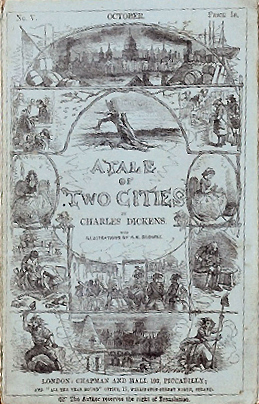
A Tale of Two Cities
A Tale of Two Cities is a historical novel published in 1859 by Charles Dickens, set in London and Paris before and during the French Revolution. The novel tells the story of the French Doctor Manette, his 18-year-long imprisonment in the Bastille in Paris, and his release to live in London with his daughter Lucie whom he had never met. The story is set against the conditions that led up to the French Revolution and the Reign of Terror.
For other uses, see A Tale of Two Cities (disambiguation).Author
Hablot Knight Browne (Phiz)
English
Weekly serial April – November 1859
Book 1859[1]
London: Chapman & Hall
United Kingdom
823.8
PR4571 .A1
As Dickens's best-known work of historical fiction, A Tale of Two Cities is said to be one of the best-selling novels of all time.[2][3][4] In 2003, the novel was ranked 63rd on the BBC's The Big Read poll.[5] The novel has been adapted for film, television, radio, and the stage, and has continued to influence popular culture.
Publication history[edit]
The 45-chapter novel was published in 31 weekly instalments in Dickens's new literary periodical titled All the Year Round. From April to November 1859, Dickens also republished the chapters as eight monthly sections in green covers. All but three of Dickens's previous novels had appeared as monthly instalments prior to publication as books. The first weekly instalment of A Tale of Two Cities ran in the first issue of All the Year Round on 30 April 1859. The last ran 30 weeks later, on 26 November.[1]
The Telegraph and The Guardian claim that it is one of the best-selling novels of all time.[2][3][25] WorldCat listed 1,529 editions of the work, including 1,305 print editions.[26]
Contemporary criticisms[edit]
The reports published in the press were divergent. Thomas Carlyle was enthusiastic, which made the author "heartily delighted".[39] On the other hand, Mrs. Oliphant found "little of Dickens" in the novel.[40] The critic James Fitzjames Stephen called it a "dish of puppy pie and stewed cat which is not disguised by the cooking" and "a disjointed framework for the display of the tawdry wares, which are Mr Dickens's stock-in-trade.[41]
Popular culture[edit]
A Tale of Two Cities served as an inspiration to the 2012 Batman film The Dark Knight Rises by Christopher Nolan. The character of Bane is in part inspired by Dickens's Madame Defarge: He organises kangaroo court trials against the ruling elite of the city of Gotham and is seen knitting in one of the trial scenes like Madame Defarge. There are other hints to Dickens's novel, such as Talia al Ghul being obsessed with revenge and having a close relationship to the hero, and Bane's catchphrase "the fire rises" as an ode to one of the book's chapters.[55] Bane's associate Barsard is named after a supporting character in the novel. In the film's final scene, Jim Gordon (Gary Oldman) reads aloud the closing lines of Sydney Carton’s inner monologue—"It's a far far better thing I do than I have ever done, it's a far far better rest I go to than I have ever known"—directly from the novel.[56]